Lukas Christ
EIHW -- Chair of Embedded Intelligence for Health Care and Wellbeing, University of Augsburg, Germany
Affective Computing Has Changed: The Foundation Model Disruption
Sep 13, 2024Abstract:The dawn of Foundation Models has on the one hand revolutionised a wide range of research problems, and, on the other hand, democratised the access and use of AI-based tools by the general public. We even observe an incursion of these models into disciplines related to human psychology, such as the Affective Computing domain, suggesting their affective, emerging capabilities. In this work, we aim to raise awareness of the power of Foundation Models in the field of Affective Computing by synthetically generating and analysing multimodal affective data, focusing on vision, linguistics, and speech (acoustics). We also discuss some fundamental problems, such as ethical issues and regulatory aspects, related to the use of Foundation Models in this research area.
This Paper Had the Smartest Reviewers -- Flattery Detection Utilising an Audio-Textual Transformer-Based Approach
Jun 25, 2024



Abstract:Flattery is an important aspect of human communication that facilitates social bonding, shapes perceptions, and influences behavior through strategic compliments and praise, leveraging the power of speech to build rapport effectively. Its automatic detection can thus enhance the naturalness of human-AI interactions. To meet this need, we present a novel audio textual dataset comprising 20 hours of speech and train machine learning models for automatic flattery detection. In particular, we employ pretrained AST, Wav2Vec2, and Whisper models for the speech modality, and Whisper TTS models combined with a RoBERTa text classifier for the textual modality. Subsequently, we build a multimodal classifier by combining text and audio representations. Evaluation on unseen test data demonstrates promising results, with Unweighted Average Recall scores reaching 82.46% in audio-only experiments, 85.97% in text-only experiments, and 87.16% using a multimodal approach.
The MuSe 2024 Multimodal Sentiment Analysis Challenge: Social Perception and Humor Recognition
Jun 11, 2024



Abstract:The Multimodal Sentiment Analysis Challenge (MuSe) 2024 addresses two contemporary multimodal affect and sentiment analysis problems: In the Social Perception Sub-Challenge (MuSe-Perception), participants will predict 16 different social attributes of individuals such as assertiveness, dominance, likability, and sincerity based on the provided audio-visual data. The Cross-Cultural Humor Detection Sub-Challenge (MuSe-Humor) dataset expands upon the Passau Spontaneous Football Coach Humor (Passau-SFCH) dataset, focusing on the detection of spontaneous humor in a cross-lingual and cross-cultural setting. The main objective of MuSe 2024 is to unite a broad audience from various research domains, including multimodal sentiment analysis, audio-visual affective computing, continuous signal processing, and natural language processing. By fostering collaboration and exchange among experts in these fields, the MuSe 2024 endeavors to advance the understanding and application of sentiment analysis and affective computing across multiple modalities. This baseline paper provides details on each sub-challenge and its corresponding dataset, extracted features from each data modality, and discusses challenge baselines. For our baseline system, we make use of a range of Transformers and expert-designed features and train Gated Recurrent Unit (GRU)-Recurrent Neural Network (RNN) models on them, resulting in a competitive baseline system. On the unseen test datasets of the respective sub-challenges, it achieves a mean Pearson's Correlation Coefficient ($\rho$) of 0.3573 for MuSe-Perception and an Area Under the Curve (AUC) value of 0.8682 for MuSe-Humor.
Modeling Emotional Trajectories in Written Stories Utilizing Transformers and Weakly-Supervised Learning
Jun 04, 2024



Abstract:Telling stories is an integral part of human communication which can evoke emotions and influence the affective states of the audience. Automatically modeling emotional trajectories in stories has thus attracted considerable scholarly interest. However, as most existing works have been limited to unsupervised dictionary-based approaches, there is no benchmark for this task. We address this gap by introducing continuous valence and arousal labels for an existing dataset of children's stories originally annotated with discrete emotion categories. We collect additional annotations for this data and map the categorical labels to the continuous valence and arousal space. For predicting the thus obtained emotionality signals, we fine-tune a DeBERTa model and improve upon this baseline via a weakly supervised learning approach. The best configuration achieves a Concordance Correlation Coefficient (CCC) of $.8221$ for valence and $.7125$ for arousal on the test set, demonstrating the efficacy of our proposed approach. A detailed analysis shows the extent to which the results vary depending on factors such as the author, the individual story, or the section within the story. In addition, we uncover the weaknesses of our approach by investigating examples that prove to be difficult to predict.
Exploring Meta Information for Audio-based Zero-shot Bird Classification
Sep 15, 2023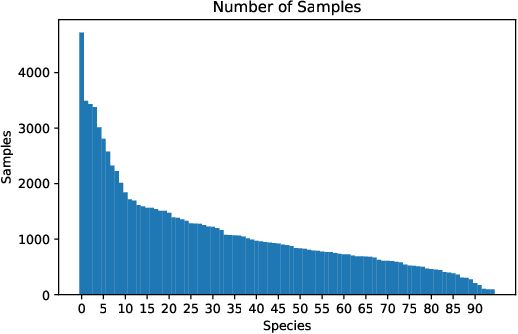
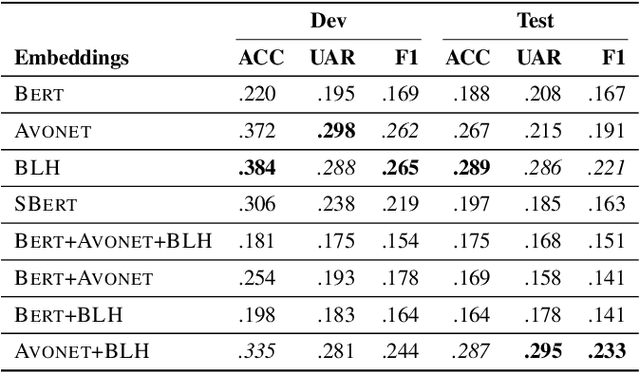
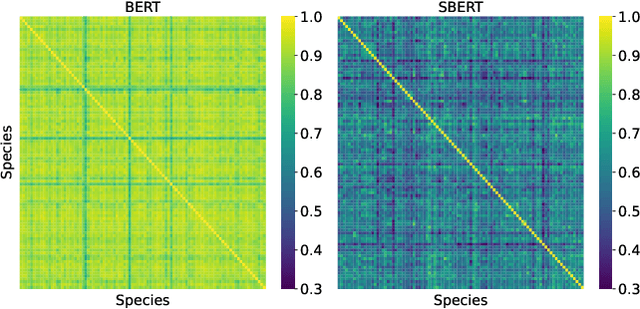
Abstract:Advances in passive acoustic monitoring and machine learning have led to the procurement of vast datasets for computational bioacoustic research. Nevertheless, data scarcity is still an issue for rare and underrepresented species. This study investigates how meta-information can improve zero-shot audio classification, utilising bird species as an example case study due to the availability of rich and diverse metadata. We investigate three different sources of metadata: textual bird sound descriptions encoded via (S)BERT, functional traits (AVONET), and bird life-history (BLH) characteristics. As audio features, we extract audio spectrogram transformer (AST) embeddings and project them to the dimension of the auxiliary information by adopting a single linear layer. Then, we employ the dot product as compatibility function and a standard zero-shot learning ranking hinge loss to determine the correct class. The best results are achieved by concatenating the AVONET and BLH features attaining a mean F1-score of .233 over five different test sets with 8 to 10 classes.
Executive Voiced Laughter and Social Approval: An Explorative Machine Learning Study
May 20, 2023

Abstract:We study voiced laughter in executive communication and its effect on social approval. Integrating research on laughter, affect-as-information, and infomediaries' social evaluations of firms, we hypothesize that voiced laughter in executive communication positively affects social approval, defined as audience perceptions of affinity towards an organization. We surmise that the effect of laughter is especially strong for joint laughter, i.e., the number of instances in a given communication venue for which the focal executive and the audience laugh simultaneously. Finally, combining the notions of affect-as-information and negativity bias in human cognition, we hypothesize that the positive effect of laughter on social approval increases with bad organizational performance. We find partial support for our ideas when testing them on panel data comprising 902 German Bundesliga soccer press conferences and media tenor, applying state-of-the-art machine learning approaches for laughter detection as well as sentiment analysis. Our findings contribute to research at the nexus of executive communication, strategic leadership, and social evaluations, especially by introducing laughter as a highly consequential potential, but understudied social lubricant at the executive-infomediary interface. Our research is unique by focusing on reflexive microprocesses of social evaluations, rather than the infomediary-routines perspectives in infomediaries' evaluations. We also make methodological contributions.
The MuSe 2023 Multimodal Sentiment Analysis Challenge: Mimicked Emotions, Cross-Cultural Humour, and Personalisation
May 05, 2023



Abstract:The MuSe 2023 is a set of shared tasks addressing three different contemporary multimodal affect and sentiment analysis problems: In the Mimicked Emotions Sub-Challenge (MuSe-Mimic), participants predict three continuous emotion targets. This sub-challenge utilises the Hume-Vidmimic dataset comprising of user-generated videos. For the Cross-Cultural Humour Detection Sub-Challenge (MuSe-Humour), an extension of the Passau Spontaneous Football Coach Humour (Passau-SFCH) dataset is provided. Participants predict the presence of spontaneous humour in a cross-cultural setting. The Personalisation Sub-Challenge (MuSe-Personalisation) is based on the Ulm-Trier Social Stress Test (Ulm-TSST) dataset, featuring recordings of subjects in a stressed situation. Here, arousal and valence signals are to be predicted, whereas parts of the test labels are made available in order to facilitate personalisation. MuSe 2023 seeks to bring together a broad audience from different research communities such as audio-visual emotion recognition, natural language processing, signal processing, and health informatics. In this baseline paper, we introduce the datasets, sub-challenges, and provided feature sets. As a competitive baseline system, a Gated Recurrent Unit (GRU)-Recurrent Neural Network (RNN) is employed. On the respective sub-challenges' test datasets, it achieves a mean (across three continuous intensity targets) Pearson's Correlation Coefficient of .4727 for MuSe-Mimic, an Area Under the Curve (AUC) value of .8310 for MuSe-Humor and Concordance Correlation Coefficient (CCC) values of .7482 for arousal and .7827 for valence in the MuSe-Personalisation sub-challenge.
HEAR4Health: A blueprint for making computer audition a staple of modern healthcare
Jan 25, 2023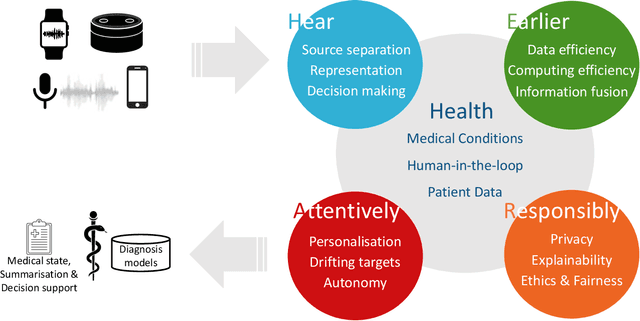

Abstract:Recent years have seen a rapid increase in digital medicine research in an attempt to transform traditional healthcare systems to their modern, intelligent, and versatile equivalents that are adequately equipped to tackle contemporary challenges. This has led to a wave of applications that utilise AI technologies; first and foremost in the fields of medical imaging, but also in the use of wearables and other intelligent sensors. In comparison, computer audition can be seen to be lagging behind, at least in terms of commercial interest. Yet, audition has long been a staple assistant for medical practitioners, with the stethoscope being the quintessential sign of doctors around the world. Transforming this traditional technology with the use of AI entails a set of unique challenges. We categorise the advances needed in four key pillars: Hear, corresponding to the cornerstone technologies needed to analyse auditory signals in real-life conditions; Earlier, for the advances needed in computational and data efficiency; Attentively, for accounting to individual differences and handling the longitudinal nature of medical data; and, finally, Responsibly, for ensuring compliance to the ethical standards accorded to the field of medicine.
Automatic Emotion Modelling in Written Stories
Dec 21, 2022Abstract:Telling stories is an integral part of human communication which can evoke emotions and influence the affective states of the audience. Automatically modelling emotional trajectories in stories has thus attracted considerable scholarly interest. However, as most existing works have been limited to unsupervised dictionary-based approaches, there is no labelled benchmark for this task. We address this gap by introducing continuous valence and arousal annotations for an existing dataset of children's stories annotated with discrete emotion categories. We collect additional annotations for this data and map the originally categorical labels to the valence and arousal space. Leveraging recent advances in Natural Language Processing, we propose a set of novel Transformer-based methods for predicting valence and arousal signals over the course of written stories. We explore several strategies for fine-tuning a pretrained ELECTRA model and study the benefits of considering a sentence's context when inferring its emotionality. Moreover, we experiment with additional LSTM and Transformer layers. The best configuration achieves a Concordance Correlation Coefficient (CCC) of .7338 for valence and .6302 for arousal on the test set, demonstrating the suitability of our proposed approach. Our code and additional annotations are made available at https://github.com/lc0197/emotion_modelling_stories.
Multimodal Prediction of Spontaneous Humour: A Novel Dataset and First Results
Sep 28, 2022
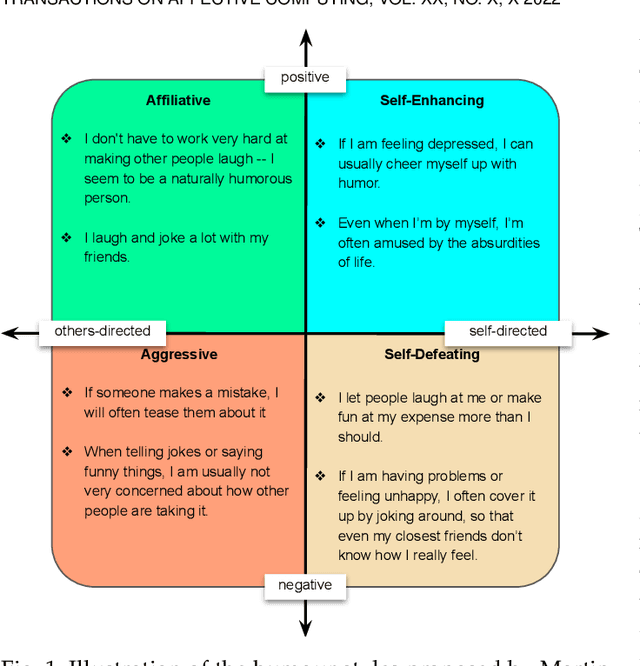
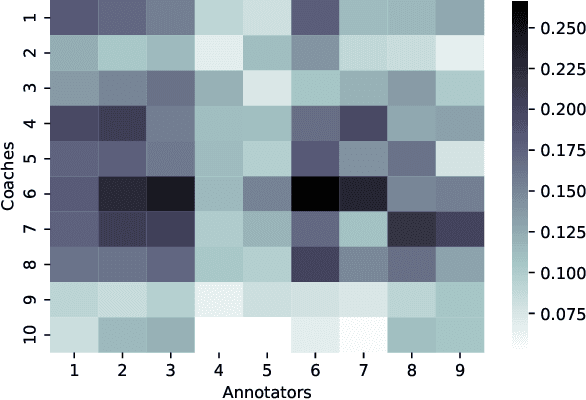

Abstract:Humour is a substantial element of human affect and cognition. Its automatic understanding can facilitate a more naturalistic human-device interaction and the humanisation of artificial intelligence. Current methods of humour detection are solely based on staged data making them inadequate for 'real-world' applications. We address this deficiency by introducing the novel Passau-Spontaneous Football Coach Humour (Passau-SFCH) dataset, comprising of about 11 hours of recordings. The Passau-SFCH dataset is annotated for the presence of humour and its dimensions (sentiment and direction) as proposed in Martin's Humor Style Questionnaire. We conduct a series of experiments, employing pretrained Transformers, convolutional neural networks, and expert-designed features. The performance of each modality (text, audio, video) for spontaneous humour recognition is analysed and their complementarity is investigated. Our findings suggest that for the automatic analysis of humour and its sentiment, facial expressions are most promising, while humour direction can be best modelled via text-based features. The results reveal considerable differences among various subjects, highlighting the individuality of humour usage and style. Further, we observe that a decision-level fusion yields the best recognition result. Finally, we make our code publicly available at https://www.github.com/EIHW/passau-sfch. The Passau-SFCH dataset is available upon request.
 Add to Chrome
Add to Chrome Add to Firefox
Add to Firefox Add to Edge
Add to Edge